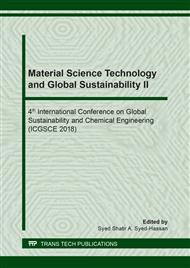[1]
S. Libes, Introduction to Marine Biogeochemistry, Elsevier Inc.,USA, (2009).
Google Scholar
[2]
M.A. Abrams, Significance of hydrocarbon seepage relative to petroleum generation and entrapment, Marine and Petroleum Geology. 22(4) (2005) 457–477.
DOI: 10.1016/j.marpetgeo.2004.08.003
Google Scholar
[3]
S. K. Samanta, O.V. Singh, & J.K. Jain, Polycyclic aromatic hydrocarbons: Environmental pollution and bioremediation, Trends in Biotechnology. 20(6) (2002) 243–248.
DOI: 10.1016/s0167-7799(02)01943-1
Google Scholar
[4]
M.P. Zakaria & H. Takada, Case Study. Oil Spills in the Strait of Malacca, Malaysia, Oil Spill Environmental Forensics. (2007) 489–504.
DOI: 10.1016/b978-012369523-9/50020-3
Google Scholar
[5]
F. Muttin, Structural analysis of oil-spill containment booms in coastal and estuary waters, Applied Ocean Research. 30(2) (2008) 107–112.
DOI: 10.1016/j.apor.2008.07.001
Google Scholar
[6]
V. Broje & A.A. Keller, Effect of operational parameters on the recovery rate of an oleophilic drum skimmer, Journal of Hazardous Materials. 148(1–2) (2007) 136–143.
DOI: 10.1016/j.jhazmat.2007.02.017
Google Scholar
[7]
M. Grote, C. van Bernem, B. Böhme, U. Callies, I. Calvez, B. Christie B, K. Colcomb, H-P. Damian, H. Farke, C. Gräbsch, A. Hunt, T. Höfer, J. Knaack, U. Kraus, S. Le Floch, G. Le Lann, H. Leuchs, A. Nagel, H. Nies, W. Nordhausen, J. Rauterberg, D. Reichenbach, G. Scheiffarth, F. Schwichtenberg, N. Theobald, J. Voß & D-S Wahrendorf, The potential for dispersant use as a maritime oil spill response measure in German waters, Marine Pollution Bulletin. April. (2017).
DOI: 10.1016/j.marpolbul.2017.10.050
Google Scholar
[8]
P. Li, Q. Cai, W. Lin, B. Chen, & B. Zhang, Offshore oil spill response practices and emerging challenges, Marine Pollution Bulletin. 110(1) (2016) 6–27.
DOI: 10.1016/j.marpolbul.2016.06.020
Google Scholar
[9]
X. Zhu, A. Venosa, M. Suidan & K. Lee, Guidelines for the bioremediation of oil-contaminated salt marshes, Epa. July (2004) 1–61.
Google Scholar
[10]
C.H. Chaîneau, G. Rougeux, C. Yéprémian, J. Oudot, Effects of nutrient concentration on the biodegradation of crude oil and associated microbial populations in the soil, Soil Biology and Biochemistry. 37(8) (2005) 1490-1497.
DOI: 10.1016/j.soilbio.2005.01.012
Google Scholar
[11]
N. Das and P. Chandran, Microbial Degradation of Petroleum Hydrocarbon Contaminants: An Overview,, Biotechnology Research International. (2011).
DOI: 10.4061/2011/941810
Google Scholar
[12]
A. Horel. & S. Schiewer, Investigation of the physical and chemical parameters affecting biodegradation of diesel and synthetic diesel fuel contaminating Alaskan soils, Cold Regions Science and Technology. 58(3) (2009) 113–119.
DOI: 10.1016/j.coldregions.2009.04.004
Google Scholar
[13]
C.B. Chikere, G.C. Okpokwasili & B.O. Chikere, Monitoring of microbial hydrocarbon remediation in the soil, 3 Biotech.1(3) (2011) 117–138.
DOI: 10.1007/s13205-011-0014-8
Google Scholar
[14]
A. Horel, B. Mortazavi, A.S Patricia, Biostimulation of weathered MC252 crude oil in northern Gulf of Mexico sandy sediments, International Biodeterioration & Biodegradation. Volume 93 (2014) 1-9.
DOI: 10.1016/j.ibiod.2014.04.025
Google Scholar
[15]
U.J.J. Ijah, H. Safiyanu, O.P. Abioye, Comparative Study Of Biodegradation Of Crude Oil In Soil Amended With Chicken Droppings And NPK Fertilizer, Science World Journal. Vol 3(2) (2008) 63-67.
DOI: 10.4314/swj.v3i2.51796
Google Scholar
[16]
Information on https://www.thestar.com.my/news/nation/2014/06/19/malaysians-eat-more-fish-than-japanese-reveals-study.
Google Scholar
[17]
N. Abdullah, F. Sulaiman, The Oil Palm Waste in Malaysia, in: M.D. Matovic, Biomass Now: Sustainable Growth and Use, IntechOpen, 2013, pp.75-100.
Google Scholar
[18]
Y.S. Hii, A.T. Law, N.A.M. Shazili, M.K. Abdul-Rashid & C.W. Lee, Biodegradation of Tapis blended crude oil in marine sediment by a consortium of symbiotic bacteria, International Biodeterioration and Biodegradation. 63(2) (2009) 142–150.
DOI: 10.1016/j.ibiod.2008.08.003
Google Scholar
[19]
Epa. Methods for Collection, Storage and Manipulation of Sediments for Chemical and Toxicological Analyses: Technical Manual. EPA 823-B-01-002. U.S. Environmental Protection Agency, Office of Water, Washington, DC. October (2011) 1–20.
Google Scholar
[20]
Ofoegbu RU, Momoh YOL, Nwaogazie IL, Bioremediation of Crude Oil Contaminated Soil Using Organic and Inorganic Fertilizers, J Pet Environ Biotechnol. 6(1) (2015) 198.
DOI: 10.4172/2157-7463.1000198
Google Scholar
[21]
P. Agamuthu, Y.S. Tan, S.H. Fauziah, Bioremediation of Hydrocarbon Contaminated Soil Using Selected Organic Wastes, Procedia Environmental Sciences. Volume 18 (2013) 694-702.
DOI: 10.1016/j.proenv.2013.04.094
Google Scholar
[22]
Cetrimide Selective Agar Intended Use. (n.d.). Retrieved from https://assets.thermofisher.com/TFS-Assets/LSG/manuals/IFU452801.pdf.
Google Scholar
[23]
B. Chettri, A. Mukherjee, J.S. Langpoklakpam, J. S., D. Chattopadhyay & A.K. Singh, Kinetics of nutrient enhanced crude oil degradation by Pseudomonas aeruginosa AKS1 and Bacillus sp. AKS2 isolated from Guwahati refinery, India, Environmental Pollution. 216 (2016) 548–558.
DOI: 10.1016/j.envpol.2016.06.008
Google Scholar
[24]
H. Gao, J. Zhang, H. Lai & Q. Xue, Degradation of asphaltenes by two Pseudomonas aeruginosa strains and their effects on physicochemical properties of crude oil, International Biodeterioration and Biodegradation. 122 (2017) 12–22.
DOI: 10.1016/j.ibiod.2017.04.010
Google Scholar
[25]
J. Thaniyavarn, A. Chongchin, N. Wanitsuksombut, S. Thaniyavarn, P. Pinphanichakarn, N. Leepipatpiboon, M. Morikawa., S. Kanaya, Biosurfactant production by Pseudomonas aeruginosa A41 using palm oil as carbon source, The Journal of General and Applied Microbiology. 52(4) (2006) 215–222.
DOI: 10.2323/jgam.52.215
Google Scholar
[26]
A. Hamzah, H. Saiful, S. Kipli & I. Rahil. Microbiological Study in Coastal Water of Port Dickson, Malaysia (Kajian Mikrobiologi Air di Pesisiran Pantai Port Dickson, Malaysia), Sains Malaysiana, 40(2) (2011) 93–99.
DOI: 10.17576/jsm-2015-4401-13
Google Scholar
[27]
J.G. Speight & N.S. El-Gendy, Introduction to petroleum biotechnology, Gulf Professional Publishing, Egypt, (2017).
Google Scholar
[28]
R. Vasanthakumari, Textbook of Microbiology, BI Publications Pvt Ltd, New Delhi, (2007).
Google Scholar
[29]
J.E. Lepo, & C.R. Cripe. Biodegradation of Polycyclic Aromatic Hydrocarbons (PAH) from crude oil in sandy-beach microcosms, in: Microbial Biosystems: New Frontiers Proceedings of the 8th International Symposium on Microbial Ecology, C.R. Bell, M. Brylinsky, P. Johnson-Green (eds) Atlantic Canada Society for Microbial Ecology, Halifax, Canada, (1999).
Google Scholar
[30]
Singh, Rajeev, Organic Fertilizers: Types, Production and Environmental Impact, Nova Science Publisher Inc., New York, (2012).
Google Scholar
[31]
K.L. Goodner .Affect of Turbidity On Color Measurements. Sensus Technical Note (SEN-TN-0007) (2008) 1–2.
Google Scholar
[32]
O. Thomas & C. Burgess, UV-visible spectrophotometry of water and wastewater (2 Ed.), Elseviee Science, (2017).
Google Scholar
[33]
N.N. Rabalais, R.E. Turner, R.J. Diaz & D. Justic, Global change and eutrophication of coastal waters, ICES Journal of Marine Science. 66(7) (2009) 1528–1537.
DOI: 10.1093/icesjms/fsp047
Google Scholar


